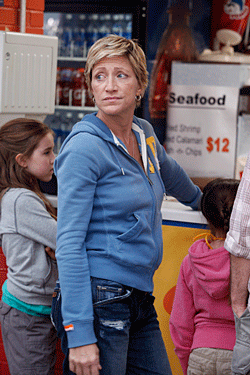While the Lifetime network may have the patent on the catchphrase “television for women,” the most provocative female leads on television these days are to be found on, of all places, premium cable’s perennial number two, Showtime. “Nurse Jackie,”“Weeds” and “United States of Tara” each offer rich, fully textured explorations of female characters never before seen on television (and infrequently on film).
Showtime was long in the shadow of HBO, first as a purveyor of theatrical released films and then in the wake of the explosion that was “The Sopranos” and “Sex and the City.” But the network seems to have found its identity as the home of more off-beat, character-driven television. “Weeds,” “Nurse Jackie” and “United States of Tara,” along with the Laura Linney vehicle “The Big C,” are representative not only of the emphasis the network has placed on courting a female audience, but the prioritization it has given to smaller, quirkier projects, which evoke the American independent-film movement of the 1990s.
Like their cinematic forerunners, “Weeds,” “Tara” and “Jackie” are full of good intentions and frequent bad choices. All three shows have moments of excellence, with “Jackie” being the most consistently strong; but all suffer from occasional moments of melodrama and self-referential cutesiness, an occupational hazard when working in the oft-maligned genre of the serio-comedy, which is often dismissively referred to as the “dramedy.”
Making a “dramedy” fire on all cylinders is a delicate undertaking. Finding the perfect measure between dramatic tension and comedic catharsis is a difficult task that often results in hyper-sentimentality or inappropriate humor.
Of the three show, “Nurse Jackie” is able to make the mark most often. It follows a hospital emergency-room nurse who also happens to be a prescription-drug addict. A brilliant study in the paradox of an addictive personality type who embeds herself in chaos and disorder, the show manages to highlight the insanity (and insane personality types) often found surrounding and sustaining an addict. The milieu of the emergency room is the perfect venue to play out both high drama as well as the laughably absurd. The ER is brilliantly juxtaposed with the sedate home environment of quasi-suburban Queens, where the heartbreaking consequences of the addict’s behavior is shown in all its uncomfortable honesty.
“Weeds,” one of the flagship shows of the network, and along with “Dexter” the primary reason for its turnaround, used to be adept at managing the tension between pathos and comedy, but it has lost steam. Entering its seventh season, it has fallen away from the sharp, albeit heavy-handed critique of middle-class mores it once was to a poorly crafted imitation of a Quentin Tarantino film.
Meanwhile, “Tara” most often falls into the unenviable category of “too cute.” It’s self-congratulatory, winking style is thanks in large part to its creator and writer Diablo Cody (the Oscar-winning writer of “Juno”), whose propensity for stylization works far better in a two-hour film than over the long haul of episodic television. Still, the show has a tremendous amount of heart and care for its characters, which in the end is its redemption.
What all three shows do very well is present fascinating character studies. Historically, television has had a tendency to paint its female leads with broad strokes. There have been exceptions, of course: in “The Mary Tyler Moore Show,” Mary Richards not only broke ground as a single career-woman in her thirties, but what was perhaps more intriguing, and often overlooked, was the ambiguity that the character had for her career, relationships and colleagues. Very little was black and white for old “Mare,” and she still remains one of the most nuanced and fully realized characters in the history of television.
While Mary Richards still might make it after all, Jackie, Tara and Nancy (“Weeds”) are just trying to make it to the end of the day. There are no happy homemakers, power brokers or women “who have it all” among the three; indeed none of the traditional archetypes apply. They are respectively: an addict, a split-personality and a drug dealer. But to reduce them to labels of any kind is antithetical to what the shows’ creators are exploring with these incredibly complicated women.
They are at once loving mothers and manipulative cons, devoted friends and sneaky adulteresses, harrowingly honest and desperately violent. Their redemption does not come in mighty winds and burning bushes, but in affirming nods and exhalations of relief. They are, like most of us, living from moment to moment, broken in a way that is not amenable to the quick fix; rather, their healings must happen over the course of a lifetime, or at least a seven season series. Revelations for these women are small and often difficult to discern amid their chaotic lives, but they do exist and are gratifying, especially to an audience fed up with quick resolves and pat solutions.
These three women are fascinating, and not solely because they are robust, thoughtfully written female characters in a medium that has not been particularly generous or kind to women. They are finally fascinating because they are all too human, bitterly human. They are struggling, often failing and always hoping for something more than their current situation promises. They are us. They are the representation of our conflicted natures: abuser and abused, lover and loved, healer and healed.
What these women offer is a truth rarely seen on television—or anywhere else for that matter.
Season 3 of "Nurse Jackie" and "United States of Tara" begins on Sunday March 28.








